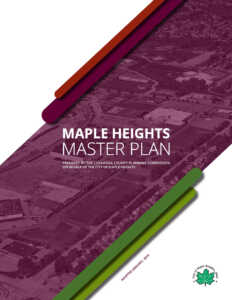
The Maple Heights Master Plan focuses on strengthening commercial centers, engaging and connecting neighborhoods, enhancing City identity, and building partnerships for regional collaboration.
The Maple Heights Master Plan is a long-term guide for the future and is meant to direct the City for the next ten years. It was adopted by Maple Heights City Council on January 2, 2019.
Maple Heights Master Plan
Document sections
Process
The Maple Heights Master Plan process kicked off in October 2017 and continued over the course of a year. A Steering Committee comprised of residents, business owners, and other stakeholders guided the plan through this process. The plan included an analysis of current conditions, the development of a vision for the future, action steps to achieve that vision, and action prioritization.
The final plan was presented to a joint meeting of Maple Heights City Council and the Maple Heights Planning Commission on October 23, 2018. It was adopted by Maple Heights City Council on January 2, 2019.
This presentation is also available for downloading.
Public Involvement
The planning process included numerous opportunities for public involvement to ensure that the plan reflected the concerns, ideas, and priorities of residents and business owners. Three public meetings were held throughout 2017 and 2018 to allow community members the opportunity to provide input. Following each public meeting, an online survey allowed additional comment, and all documents were posted online. Over the course of the plan, approximately 60 people attended in-person meetings, 36 completed online surveys, and more than 380 individual comments were provided.
Master Plan Structure
The Maple Heights Master Plan included eight Vision Principles covering high-quality neighborhoods, diverse housing, community engagement, positive identity, a complete transportation network, great parks, commercial vibrancy, and economic growth. Together, these principles laid the foundation for all the plan’s Goals and Actions. These Goals and Actions were grouped into a Place-Based Framework that outlined recommendations for particular locations in Maple Heights as well as a Citywide Framework that outlined changes to city policy that would benefit the community as a whole.

Goals & Actions: Place-Based Framework
The Place-Based Framework identifies the key components of the Master Plan. They are specific areas where investments are encouraged in order to target growth.
The framework identifies a series of actions within areas and corridors that would work together to form a vibrant and connected Maple Heights that matches the Vision Principles. The images below showcase the components of this framework.
Each of these components is further explained in detail with associated maps, images, text, and actions. Below is an example from Maple Point, the center of the city and an area with the potential for development. The Place-Based Framework outlined actions for the improvement of streetscapes, construction of trails, beautification of gateways, and addition of parks in Maple Point. The plan also specifically included ideas for how an existing shopping center could be reorganized to include landscaping, public spaces, safe pedestrian connections, and new storefronts. That redevelopment plan is shown below.

Goals & Actions: Citywide Framework
Beyond plans for individual places in Maple Heights, the plan also identified a framework of citywide policy goals and actions. They included the following:
- Foster community pride and neighborhood networks
- Stabilize the housing market and encourage reinvestment in neighborhoods
- Improve the vibrancy of the City’s business districts
- Encourage walking and bicycling
- Protect the City’s critical environmental features
- Revitalize existing parks and strategically enhance the City’s recreation system
- Coordinate infrastructure improvements
- Develop a comprehensive system of youth engagement
- Grow manufacturing jobs








